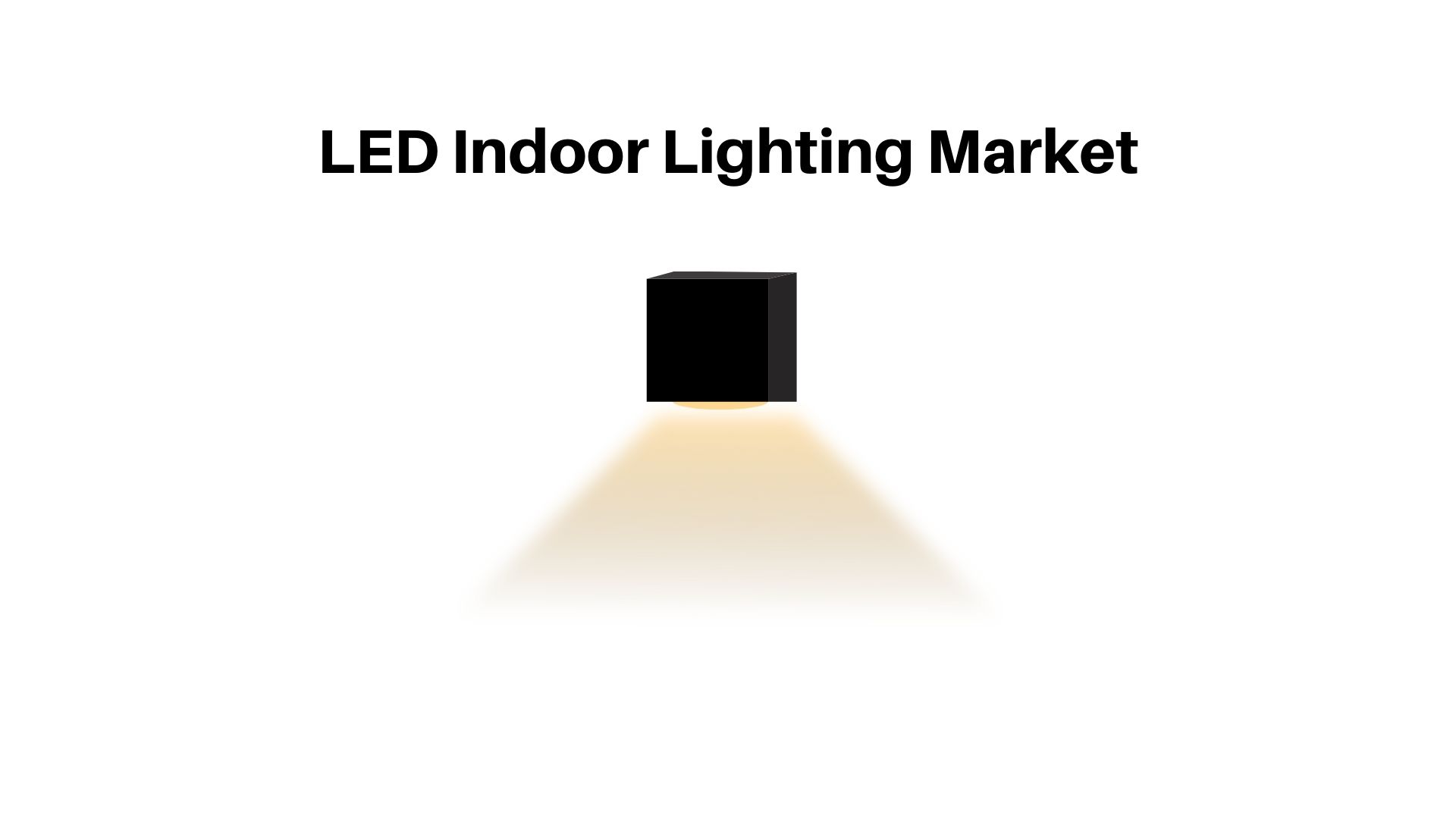LED Indoor Lighting Market is poised to grow at a CAGR of 12.5% by 2032

Page Contents
Market Overview
Published Via 11Press: The LED Indoor Lighting Market size is expected to be worth around USD 9.9 Bn by 2032 from USD 3.2 Bn in 2022, growing at a CAGR of 12.5% during the forecast period from 2022 to 2032.
The LED Indoor Lighting market has witnessed significant growth in recent years with the increasing demand for energy-efficient lighting solutions. As consumers become more environmentally conscious, they are gravitating towards LED lighting products that consume less energy and last longer than traditional lighting fixtures. This trend is not only driven by consumer preferences but also by government regulations to promote energy efficiency.
LED indoor lighting technology has advanced significantly over the past decade, resulting in a wide range of options for consumers to choose from. From color temperature to brightness levels and even smart home integration, manufacturers continue to innovate their products to cater to different needs and preferences. Additionally, LED indoor lighting is cost-effective in the long run since it consumes less energy and requires fewer replacements than traditional lighting fixtures.
The LED Indoor Lighting market is poised for continued growth as more households and businesses switch to this sustainable alternative.
Request For Sample Report Here: https://market.us/report/led-indoor-lighting-market/request-sample/

Key Takeaways
- LED Lighting Adoption: LED lighting technology is becoming more and more popular in indoor lighting applications due to its energy efficiency, long lifespan, and minimal upkeep requirements.
- Energy Efficiency Regulations: Government regulations and initiatives to reduce energy consumption and carbon emissions are propelling the growth of the LED indoor lighting industry.
- Cost Effectiveness: With LED lighting's cost reduction over recent years, it has become an increasingly cost-effective solution for indoor lighting applications.
- Smart lighting systems: The integration of LED lighting with advanced technologies like sensors and controls is expected to fuel the growth of the LED indoor lighting indsutry.
- Residential and Commercial Applications: The LED indoor lighting market is being driven by both residential and commercial applications, such as homes, offices, schools, hospitals, and retail spaces.
- LED Lighting Gaining Recognition for Health Benefits: As LED lighting gains recognition for its potential health advantages, such as reducing eye strain and improving sleep quality, more people are taking advantage of its potential advantages – an outlook that is expected to lead to further adoption rates.
- Key Players: Some of the leading companies in the LED indoor lighting market include Philips, Osram, Cree, GE Lighting, MaxLite, Hugewin, Gemcore, Westinghouse, DECO Lighting, XtraLight, RAB Lighting, Havells Sylvania, Toshiba, Acuity Brands, Emerson Electric, LSI, Bravoled, Hubbell Lighting, Ligman Lighting
Regional Analysis
- North America The LED indoor lighting market in North America is expected to experience significant growth due to government initiatives to reduce energy consumption and carbon emissions, as well as the increasing adoption of smart lighting systems. The United States leads the region's LED indoor lighting market share.
- Europe The LED indoor lighting market in Europe is expected to expand due to energy efficiency regulations and the increasing adoption of LED technology. Germany, France, and the United Kingdom are three key markets within this region.
- Asia-Pacific The LED indoor lighting industry in Asia-Pacific is forecast to experience the highest growth rate due to urbanization and industrialization within the region, as well as the growing demand for energy-saving lighting solutions. China, India, and Japan are the three largest markets within this region.
- Latin America The LED indoor lighting market in Latin America is expected to experience moderate growth due to the region's economic development and increasing awareness of energy-saving lighting solutions. Brazil and Mexico are the two largest markets within this region.
- Middle East & Africa The LED indoor lighting market in the Middle East & Africa is expected to experience moderate growth due to an increasing focus on energy efficiency and sustainability in the region. The United Arab Emirates and Saudi Arabia are the two largest markets within this region.
- Overall, the LED indoor lighting market is expected to experience substantial growth across all regions due to the increasing adoption of LED lighting technology and growing demand for energy-saving lighting solutions.
Drivers
- Energy-Efficient Lighting: LED lighting is highly energy-efficient compared to traditional lighting technologies such as incandescent and fluorescent. This has been a major driver of the LED indoor lighting market, helping reduce both energy consumption and costs.
- Longevity: LED lighting has a much longer lifespan than traditional lighting technologies, which reduces maintenance expenses and boosts overall cost-effectiveness.
- Environmental Regulations: Governments around the world have implemented regulations to reduce energy consumption and carbon emissions, which has spurred the adoption of LED lighting in indoor applications.
- Decreasing Costs: LED lighting has seen a dramatic decrease in price over the last several years, making it increasingly cost-effective for indoor lighting applications.
- Smart Lighting Systems: The integration of LED lighting with advanced technologies such as sensors and controls is propelling the growth of the LED indoor lighting inustry, offering greater energy efficiency and customization options.
- Health Benefits: LED lighting is being increasingly recognized for its potential health advantages, such as reducing eye strain and improving sleep quality. This has spurred the adoption of LED lighting indoor applications, particularly residential ones.
- Design Flexibility: LED lighting offers greater design freedom compared to traditional lighting technologies, enabling more creative and customizable indoor lighting solutions.
- Overall, LED indoor lighting market growth is being driven primarily by energy efficiency, cost-effectiveness, and design versatility, with increasing awareness of its health benefits and smart capabilities fuelling further expansion.
Restraints
- Higher upfront costs: Though LED lighting costs have steadily decreased in recent years, their initial outlay remains higher compared to traditional lighting technologies. This may present a barrier for some customers, particularly in low-income markets.
- Lack of Awareness: Unfortunately, some customers still lack awareness regarding the advantages of LED lighting, particularly in emerging markets. This could hinder its adoption by these markets.
- Quality Control Issues: The LED indoor lighting market is highly competitive, which may lead to quality control problems and product variability. This could result in customer dissatisfaction and slow the adoption of LED lighting.
- Technical Challenges: The LED indoor lighting industry faces several technical difficulties, such as color rendering and light distribution issues. These obstacles may reduce the quality of illumination and impede its widespread adoption in certain applications.
- Temperature Sensitivity: LED lighting is temperature sensitive, which can significantly affect its lifespan and performance. This poses a challenge in certain indoor applications, particularly in hot climates.
- Overall, while the LED indoor lighting market has many positive factors, there are also some significant obstacles that could hinder the adoption of this technology. These include higher upfront costs, lack of awareness, quality control issues, technical difficulties, and temperature sensitivity.
Opportunities
- Emerging Markets: Emerging markets such as Asia-Pacific, Latin America, and the Middle East & Africa provide significant growth prospects for the LED indoor lighting market. These regions boast large populations and rapid urbanization rates, creating a demand for energy-saving lighting solutions.
- Smart Lighting Systems: The integration of LED lighting with smart technologies such as sensors and controls offers significant growth prospects for the LED indoor lighting market. These systems promote energy efficiency, customization, data collection, and analysis.
- Health Benefits: With increasing awareness of LED lighting's potential health advantages, such as reducing eye strain and improving sleep quality, there are now opportunities for the LED indoor lighting market, particularly in residential applications.
- Design Flexibility: LED indoor lighting offers designers a multitude of design possibilities, offering them the ability to craft new and inventive indoor lighting solutions, particularly for commercial applications.
- Government Regulations: Government regulations and initiatives to reduce energy consumption and carbon emissions offer opportunities for the LED indoor lighting market to grow, particularly in regions with stringent environmental laws such as Europe or North America.
- Increased Focus on Sustainability: With the growing concern for sustainability among businesses and consumers alike, LED indoor lighting markets can take advantage of this trend to position themselves as more eco-friendly alternatives to traditional lighting technologies.
- Overall, the LED indoor lighting industry offers numerous growth prospects due to emerging markets, smart lighting systems, health advantages, design versatility, government regulations, and sustainability trends.
Browse the summary of the report and Complete Table of Contents (TOC): https://market.us/report/led-indoor-lighting-market/table-of-content/
Challenges
- Price Competition: The LED indoor lighting market is highly competitive, which may lead to price cuts and reduced profit margins for companies.
- Technical Challenges: LED lighting may encounter technical difficulties such as color rendering and light distribution issues. These obstacles may affect the quality of light produced, slowing down its adoption in certain applications.
- Quality Control Issues: The LED indoor lighting market is highly competitive, which may lead to quality control problems and product variability. This could cause customer dissatisfaction and hinder the adoption of LED lighting by businesses.
- Lack of Standardization: In the LED lighting industry, there is a lack of standardization that could cause compatibility issues between products and confusion among customers.
- Temperature Sensitivity: LED lighting is temperature sensitive, which can significantly affect its lifespan and performance. This could pose a problem in certain indoor applications, especially in hot climates. Intellectual Property Issues Intellectual property issues can present a challenge in the LED indoor lighting industry, particularly for companies developing new technologies or products.
- Disposing of LED: Lighting at End-Of-Life LED lighting contains hazardous materials like lead and mercury that pose challenges during end-of-life disposal.
- Overall, while the LED indoor lighting industry offers significant growth prospects, there are also some key challenges facing it. These include price competition, technical difficulties, quality control issues, lack of standardization, temperature sensitivity issues, intellectual property rights violations, and end-of-life disposal concerns.
Report Scope
| Report Attribute | Details |
| The market size value in 2022 | USD 3.2 Bn |
| Revenue forecast by 2032 | USD 9.9 Bn |
| Growth Rate | CAGR Of 12.5% |
| Regions Covered | North America, Europe, Asia Pacific, Latin America, and Middle East & Africa, and the Rest of the World |
| Historical Years | 2017-2022 |
| Base Year | 2022 |
| Estimated Year | 2023 |
| Short-Term Projection Year | 2028 |
| Long-Term Projected Year | 2032 |
Key Market Segments
Type
- <60w
- 60w-100w
- >100w
Application
- Healthcare Indoor Lighting
- Commercial Indoor Lighting
- Industrial Indoor Lighting
- Home Indoor Lighting
- Other
Key Market Players included in the report:
- Philips
- Osram
- Cree
- GE Lighting
- MaxLite
- Hugewin
- Gemcore
- Westinghouse
- DECO Lighting
- XtraLight
- RAB Lighting
- Havells Sylvania
- Toshiba
- Acuity Brands
- Emerson Electric
- LSI
- Bravoled
- Hubbell Lighting
- Ligman Lighting
Frequently Asked Questions
What is the market study period?
The LED Indoor Lighting Market is studied from 2017 – 2032.
What is the growth rate for the LED Indoor Lighting Market?
The LED Indoor Lighting Market is growing at a CAGR of 12.5%
Who are the major players in the LED Indoor Lighting Industry?
Philips, Osram, Cree, GE Lighting, MaxLite, Hugewin, Gemcore, Westinghouse, DECO Lighting, XtraLight, RAB Lighting, Havells Sylvania, Toshiba, Acuity Brands, Emerson Electric, LSI, Bravoled, Hubbell Lighting, Ligman Lighting
The team behind market.us, marketresearch.biz, market.biz and more. Our purpose is to keep our customers ahead of the game with regard to the markets. They may fluctuate up or down, but we will help you to stay ahead of the curve in these market fluctuations. Our consistent growth and ability to deliver in-depth analyses and market insight has engaged genuine market players. They have faith in us to offer the data and information they require to make balanced and decisive marketing decisions.



